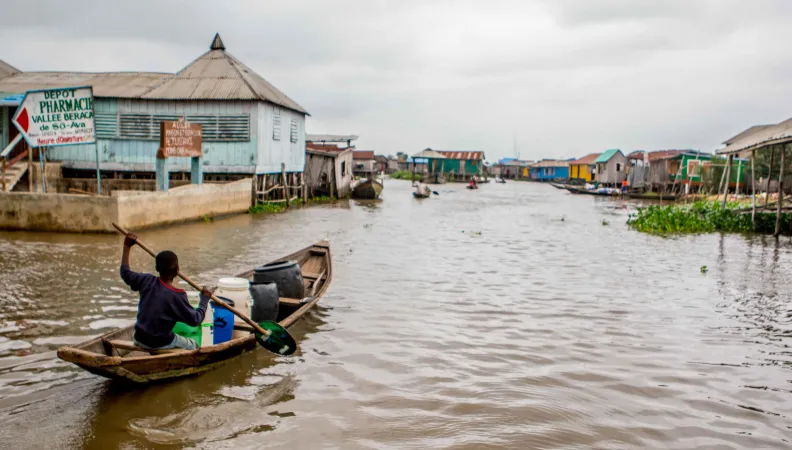Share the page
Reinventing the “Venice of Africa”
Published on

In the south of Benin, in the lake village of Ganvié, buildings are perched on stilts, and traffic consists not of cars, but canoes. Yet the the picturesque site known as the “Venice of Africa" is being threatened by the combined effects of climate change, pollution and a growing population. AFD Group is supporting moves to protect the area, in a project known as “Reinventing the Lake Village of Ganvié."
Whether they’re heading to school or work, or running errands, residents of Ganvié navigate the village by boat, as its buildings sit atop stilts, with stairs leading down to Lake Nokoué. Just 30 km from Cotonou, Ganvié is on “UNESCO’s Tentative List” to be join the world’s heritage sites.
Ganvié means "we survived" in the local language
Ganvié served as a refuge in the 18th century for people escaping slave raids. Armed men from the nearby Fon and Dahomey kingdoms captured people and sold them to Portuguese slave traders. Villagers’ ancestors fled to this area and built a new village on stilts knowing they would be safe from their pursuers, who believed a demon lived below the water’s surface.
Now the threat comes from climate change, a burgeoning population and inadequate infrastructure. The region is increasingly exposed to severe weather conditions, recurrent flooding, and heavy humidity. Organic waste and domestic wastewater flow into the lake, which lacks any filtration system. What’s more, most homes are not connected to an electricity network and it is difficult for households to have access to schools and health facilities.
Ganvié may be called the “Venice of Africa”, but it hasn’t received the same support or resources as its Italian cousin. But in 2019, the Government of Benin set out to “reinvent the lake village” through an ambitious program to preserve, renovate and develop the village’s infrastructure. The project, backed by AFD, aims to improve living conditions and reduce the pollution and adverse effects in the lake ecosystem. The project is also improving accessibility and infrastructure.
Further reading: Promoting historical heritage in Benin
A night lighting system has made it easier for people to move about more safely, and “model houses” have been built as part of the rehabilitation program for dilapidated and fragile buildings. Water pollution is now monitored and measured.
Turning weaknesses into strengths
While the population still depends heavily on fishing, the need to filter water led to the introduction of water hyacinth, imported from Latin America in the 19th century. Unfortunately, the uncontrolled proliferation of the plant deprives the lake of its oxygen and now threatens the ecosystem. The presence of water hyacinth creates competition with fish, which are also threatened by backfill in the lake, its pollution and overfishing. For residents, water hyacinths also hinder the circulation of dugout canoes, the only means of transport on the lake.
Further reading: CICLIA, Climate at the Heart of Cities’ Development
But just as Ganvié has managed to turn its fragile houses on stilts into a tourist attraction, this apparent threat from plants can also be transformed into a valuable asset. A specialist in innovative, natural and de-pollution solutions, Green Keeper Africa is a stakeholder in the "Reinventing the Lake Village of Ganvié" program.
This Beninese company is turning water hyacinth into a resource in three ways: via a botanical observatory to better understand the dynamics associated with the plant; an action-research platform for hyacinth harvesting and recovery; and a micro-enterprise incubator to achieve social, environmental and economic benefits for the village and its residents.
Promoting ecotourism and sustainable development
Through partnerships with the social enterprise Green Keeper Africa and the NGO JEVEV, Benin’s National Agency for Heritage Promotion and Tourism Development (ANPT) is implementing the projects “Ganvié, Innovative Laboratory with High Potential for Transformation” and “The Route of the Water Hyacinth” with AFD’s support.
Its long-term objective is to design an ecotourism circuit based on products from the recovery of hyacinth, to promote entrepreneurship and develop an action-research platform.
Locals are receiving training in compost production, craft trades and the sale of products sourced from this plant. Studies and research are being conducted generate benefits for residents, including: 75 tons of water hyacinth harvested to improve water oxygenation, over 1,000 young people trained in activities to develop products using the plant and the organization and training of 24 cooperatives. All this is expected to boost its tourism sector, which rivals the fishing industry.
